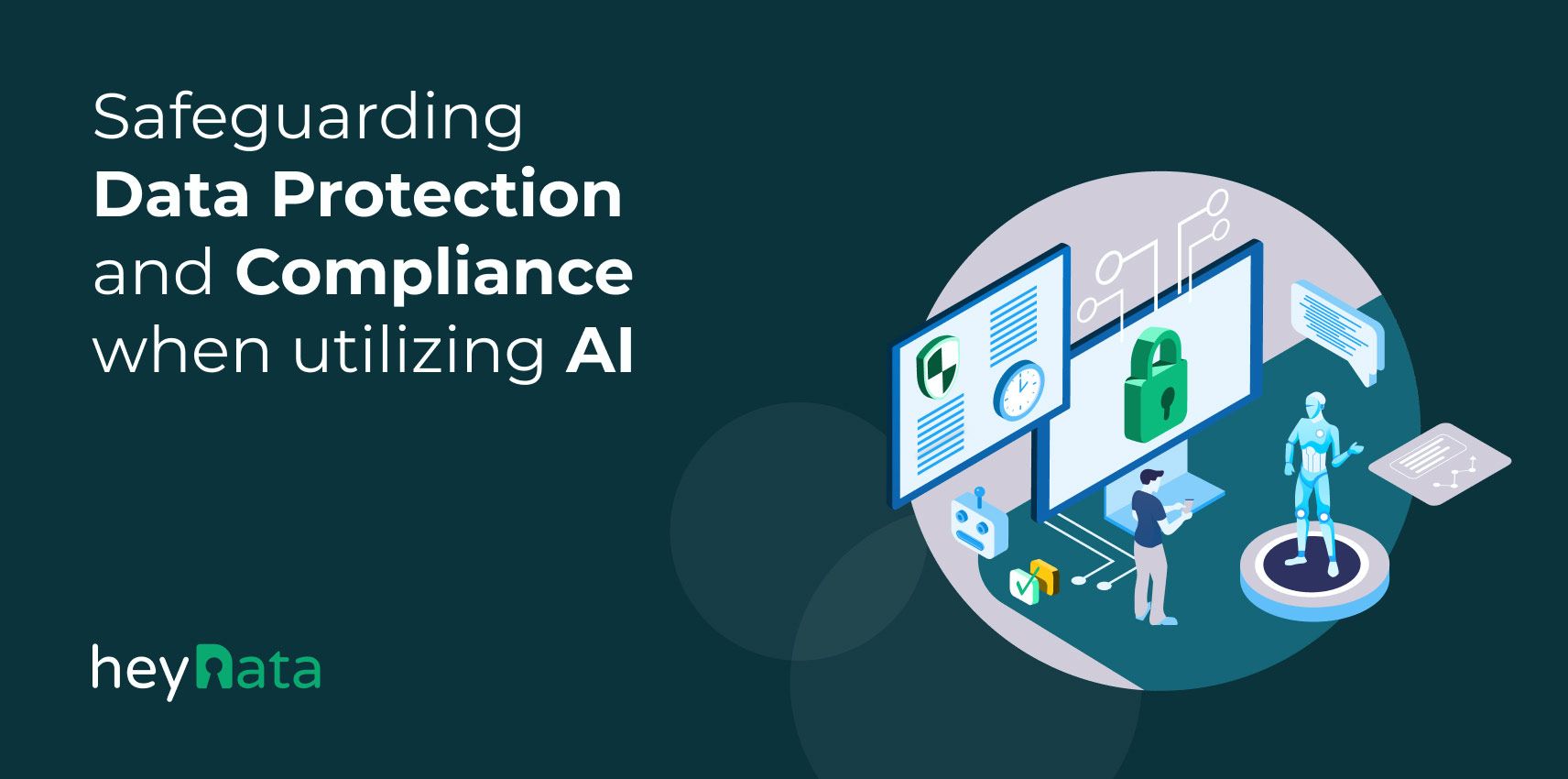
Safeguarding Data Protection and Compliance when utilizing AI

In the era of artificial intelligence (AI), organizations are increasingly leveraging advanced algorithms to gain valuable insights, automate processes, and enhance decision-making. However, the use of AI brings significant considerations related to data protection and compliance. Safeguarding personal data and ensuring data compliance with privacy regulations are essential aspects to address when implementing AI solutions. In this comprehensive guide, we will explore key factors to consider, drawing upon the expertise of heyData in the field of General Data-Protection Regulation (GDPR) and data privacy. By following these recommendations, you can ensure that your AI initiatives align with legal requirements, foster trust, and respect individual privacy rights.
Table of Contents:
1. Data Privacy: Understanding Applicable Regulations
When incorporating artificial intelligence (AI) into your operations, it’s crucial to have a solid understanding of the relevant data protection and privacy regulations in your jurisdiction. In jurisdictions such as the European Union, compliance with laws like the General Data Protection Regulation (GDPR) is essential to avoid legal ramifications and maintain trust with stakeholders. Familiarizing yourself with key principles such as lawfulness, fairness, transparency, purpose limitation, data minimization, and accountability is foundational for ensuring ethical and lawful AI practices.
The principle of lawfulness requires that the processing of personal data is based on a legitimate basis, such as consent, contractual necessity, legal obligations, vital interests, public task, or legitimate interests. Ensure that your AI initiatives have a lawful basis for processing personal data.
Fairness and transparency entail providing individuals with clear and understandable information about how their data will be processed, including the purposes of processing and the rights they have regarding their data. Implement mechanisms to provide individuals with privacy notices or policies that outline these details.
Purpose limitation emphasizes collecting and retaining personal data only for specific, well-defined purposes. Avoid unnecessary data accumulation by regularly reviewing and reassessing the data you collect and ensuring it aligns with the purposes of your AI initiatives.
Data minimization advocates for collecting and storing only the minimum amount of personal data necessary to achieve the intended AI objectives. This principle helps mitigate privacy risks and protects individuals from unnecessary data processing.
Accountability requires organizations to demonstrate compliance with data protection regulations. Maintain records of processing activities, including information on data controllers, data processors, data categories, data recipients, and data transfers. Conduct data protection impact assessments (DPIAs) for high-risk AI processing activities and implement appropriate safeguards to protect personal data.
Aligning with the EU AI Act Objectives:
The EU AI Act aims to balance innovation and protection of fundamental rights, setting a global standard for AI governance. It emphasizes safeguarding fundamental rights such as fairness, non-discrimination, privacy, and safety, while also promoting innovation and investment by categorizing AI systems based on risk levels. This legislation positions the EU as a leader in ethical and human-centric AI, influencing global AI governance standards and encouraging similar approaches worldwide.
2. AI or Artificial intelligence: Data security and encryption
Protecting the data processed by AI systems is of paramount importance. Implement robust security measures to safeguard sensitive information from unauthorized access or interception. Encryption is a powerful tool that can be employed to convert data into an unreadable format, limiting its accessibility to those without authorized access. It involves the use of cryptographic algorithms to encode data, rendering it unintelligible to anyone who does not possess the decryption key. By adhering to industry best practices and employing encryption technologies, you can prevent data breaches and ensure the confidentiality and integrity of the data.
Implement a comprehensive information security program that encompasses measures such as access controls, secure storage and transmission protocols, intrusion detection systems, and regular security audits. Conduct vulnerability assessments and tests to identify and address potential weaknesses in your AI systems. Train your employees on data security best practices and establish clear guidelines for handling and protecting sensitive data. Consider the use of encryption not only for data at rest but also during data transmission. Secure protocols such as HTTPS and secure file transfer protocols (SFTP) can help ensure the encrypted transfer of data between systems. Encryption can also be applied at the field level, allowing you to encrypt specific sensitive data elements within a larger dataset. Regularly update and monitor your encryption mechanisms to stay ahead of emerging threats and vulnerabilities.
3. Data privacy: Anonymization and pseudonymization
Anonymization and pseudonymization techniques play a crucial role in enhancing privacy when utilizing AI. Anonymization involves the removal or alteration of personally identifiable information (PII) from data, making it impossible to link the information back to individuals. By anonymizing the data, you protect individual privacy while still being able to extract valuable insights from the dataset.
Pseudonymization, on the other hand, involves replacing identifying elements with artificial identifiers. This process allows for the separation of sensitive information from the actual individuals, reducing the risks associated with the processing of personal data. Pseudonymization can provide an additional layer of privacy protection while still allowing for effective data analysis.
While these techniques can mitigate privacy risks, there is always a small risk of re-identification or de-anonymization, especially when dealing with large and diverse datasets. It is crucial to assess the effectiveness of these methods in your specific AI use case and consider additional safeguards, such as strict access controls and secure data handling practices.
4. AI or Artificial intelligence: Transparency and explainability
Transparency and explainability are essential when using AI systems to comply with data protection regulations. AI algorithms can be complex and opaque, making it challenging for individuals to understand the decision-making processes behind the algorithms. To ensure data compliance and build trust, it is crucial to provide clear explanations of how your AI models operate, the data used, and the logic behind the decisions made.
Documenting the AI processes and making this information available to individuals can help promote transparency and accountability. This documentation should include details such as the data sources, data preprocessing methods, feature selection, model training techniques, and validation processes. By providing individuals with understandable information about how their data is being processed, you empower them to exercise their rights, such as the right to access, rectify, or erase their personal data.
Implementing effective mechanisms to handle user inquiries and requests is also essential. Establish clear channels for individuals to make inquiries or submit requests regarding their data. Respond promptly and accurately to these inquiries, ensuring that individuals' rights are respected and fulfilled.
By prioritizing transparency and explainability, you build trust with individuals whose data is processed by your AI systems. This fosters a positive relationship between your organization and the individuals you interact with, promoting data compliance with data protection regulations and protecting individual privacy rights.
Related topic: Safeguarding User Privacy in the Digital Age: Personal Data and AI Training Ethics
5. Data privacy: User consent and opt-out options
Obtaining informed and valid consent from individuals whose data is processed by AI under the legal basis of consent a fundamental requirement for ensuring data protection and data compliance. It is essential to communicate the purposes, scope, and potential risks associated with data processing to users, enabling them to make informed decisions about their personal information. Transparency is key in building trust and fostering a relationship based on respect for privacy.
To obtain valid consent, organizations should ensure that their consent mechanisms are prominent, user-friendly, and accessible. This includes presenting consent requests clearly and understandably, using plain language without legal jargon. Consent forms should be easy to read, and individuals should be able to provide their consent without any ambiguity or confusion.
Additionally, if the processing is based on the user’s consent, organizations must provide clear and accessible mechanisms for individuals to opt out of data processing activities if they choose to do so. This empowers individuals to maintain control over their personal information and exercise their rights. Opt-out options should be clearly communicated and readily available to individuals, allowing them to withdraw their consent or object to specific data processing activities easily. Organizations should also consider implementing a preference management system that allows individuals to manage their consent preferences over time. This system should provide individuals with the flexibility to update their consent choices and exercise their rights effectively.
By prioritizing informed and valid consent, as well as providing accessible opt-out options, organizations can empower individuals to maintain control over their personal information. This not only demonstrates a commitment to data protection and privacy but also builds trust and fosters a positive relationship between organizations and individuals.
Related topic: GDPR Email Marketing: Risks and Compliance Best Practices
6. Regular assessments and compliance monitoring for Data Privacy
Continuously monitoring and assessing your AI systems is essential to ensure ongoing compliance with data protection regulations. Regular audits and reviews of data processing activities, policies, and procedures help identify any gaps or areas for improvement in your data-protection practices. By conducting these assessments, you can proactively address any compliance issues and mitigate potential risks. During assessments, evaluate the effectiveness of your data-protection measures, including security controls, data access controls, encryption mechanisms and data retention policies. Assess the accuracy and completeness of your data inventory, ensuring that you have a comprehensive understanding of the personal data you process. Identify any potential areas where improvements can be made to enhance data protection.
It is crucial to stay updated on emerging regulations and guidance related to AI and data privacy. Regulatory frameworks and best practices evolve over time, and it is essential to adapt your practices accordingly. Stay informed about changes in data protection regulations, such as amendments to existing laws or the introduction of new regulations. This includes keeping up to date with guidelines provided by regulatory authorities or industry associations. To ensure compliance, establish a robust compliance monitoring program that includes regular assessments, reviews, and updates. This program should outline the frequency and scope of assessments, as well as the responsible parties involved. Assign designated personnel or a compliance team to oversee and coordinate these activities.
Incorporate privacy-by-design principles into your AI initiatives and conduct privacy impact assessments (PIAs) or data-protection impact assessments (DPIAs) for high-risk processing activities. These assessments help identify and mitigate privacy risks associated with AI systems and ensure compliance with data protection regulations.
Conclusion
As you venture into the realm of AI, it is crucial to prioritize data protection and compliance. By understanding the applicable regulations, implementing robust security measures, ensuring transparency and explainability, and obtaining valid user consent, you can use AI responsibly while preserving privacy. With the upcoming EU AI Act poised to set new standards for AI governance, heyData stands ready to help your company adapt and thrive in this evolving regulatory landscape. With heyData, you can confidently harness the potential of AI while ensuring privacy protection and compliance with emerging regulations. Learn more about the official release of heyData's AI Solution AI Comply and empower your business to thrive responsibly in the AI era.


